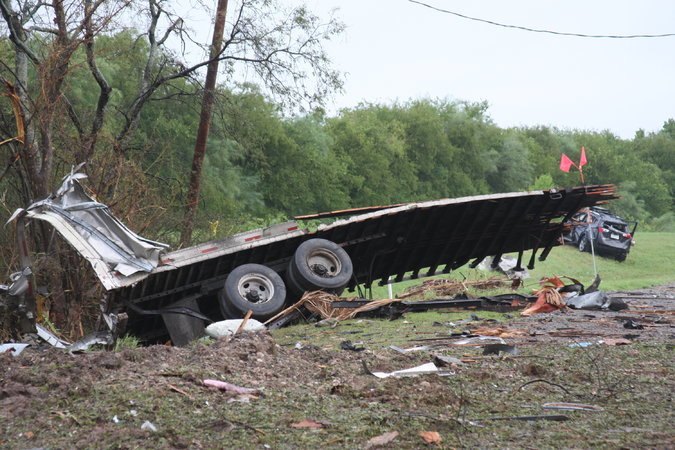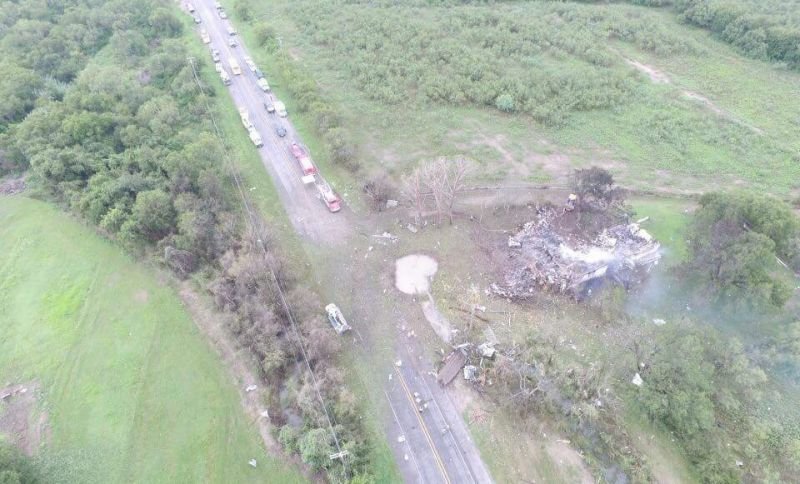The immense blast — the victim's remains were not located for two days — highlighted the potency of the explosives used by Takata in its airbags as a propellent to activate its bags in a car crash. It also pointed to the risks associated with Takata's transport of the explosives across the country from a propellant factory in Washington State to Mexico.
Takata's airbags, and the explosive material used to make them, are at the center of the largest auto safety recall in history. Takata airbags installed in automobiles can explode violently when activated, and have been linked to the deaths of at least 14 drivers as well as to the injuries of over 100 people. Fourteen automakers have recalled more than 64 million inflaters over the defect.
The airbags use a propellant based on ammonium nitrate, which has come under scrutiny for its tendency to break down over time and combust violently when triggered.
In last week's accident, which occurred in the early hours of Aug. 22, the woman who died, Lucila Robles, 69, was apparently in her home in the town of Quemado, on the Mexico border, when the crash occurred on the road in front of her property before dawn.
The blast destroyed the home. The sheriff's office sent out search parties for Ms. Robles, thinking she may have been carried by the force of the explosion into nearby brush.
Investigators called off the search after two days when they discovered Ms. Robles's bones, teeth and other remains in the smoldering debris of her house, said Tom Schmerber, the local sheriff for the county of Maverick. Also injured were the two drivers of the truck, who fled their vehicle after it swerved off the road and crashed, and two passers-by in a car.
An internal document provided by a former Takata employee shows that Takata transports its explosive compound more than 2,000 miles across the United States, from its propellant-manufacturing plant in Moses Lake, Wash., to a distribution center just north of the Mexico border in Eagle Pass, Tex.
The 36-hour journey, manned by two drivers, takes the truck through Boise, Idaho, and Salt Lake City, as well as Albuquerque and Santa Fe, N.M., according to the document, dated October 2007. From Eagle Pass, the propellant is transferred to separate trucks that then travel to Takata's airbag factory in Monclova, Mexico, according to the document.

Takata said the trucks were carrying the propellant alongside airbag components called inflaters, which are small devices within an airbag that contain the explosive material and which are designed to cause an airbag to inflate in microseconds. The inflaters aboard the truck were newly manufactured, the company said.
In a statement, a spokesman for Takata, Jared Levy, said the company followed all regulatory requirements.
Glenn P. Wicks, managing director at the Wicks Group, a law firm based in the District of Columbia that specializes in hazmat transportation, said it was not immediately clear whether any federal safety regulations were violated in Takata's shipping of the propellant and inflaters. Given the severity of the crash, he said, the ammonium nitrate propellant could have triggered an explosion by itself, with or without the inflaters present.
Still, investigators are likely to scrutinize how the propellant was packaged and shipped, whether the drivers were certified to handle hazardous materials and whether their working hours were within legal limits, Mr. Wicks said.
The Department of Transportation said its investigators were working closely with local officials in Texas to look into the crash and explosion. "Every possible factor or factors — including the safety compliance of the motor carrier, the handling of the cargo by the shipper, its packaging, how the truck was placarded, as well as the truck's routing — and all other aspects will be thoroughly investigated to determine whether there were violations of any U.S. Department of Transportation safety regulations, which exist to protect everyone's safety," the agency said.
The explosion is not Takata's first accident involving ammonium nitrate. In March 2006, its Monclova plant was severely damaged by a series of blasts blamed on the ammonium nitrate propellant. There were no injuries, although the explosions blew out the windows of nearby homes and forced hundreds of workers and local residents to evacuate.
Takata said the truck was operated by a subcontractor, which it did not name. The supplier immediately sent personnel to the site and has been cooperating with local investigators, Mr. Levy said in a statement.
"Takata has strict safety procedures relating to the transportation of its products that meet or exceed all regulatory requirements," he said. "Our thoughts are with the family of the woman who died as a result of this accident, and with the four people injured."




I just don't think I read nearly anything like this in advance of. Thanks for your own marvelous post.I really enjoyed looking through it; you'll be a great article writer.
[Link]